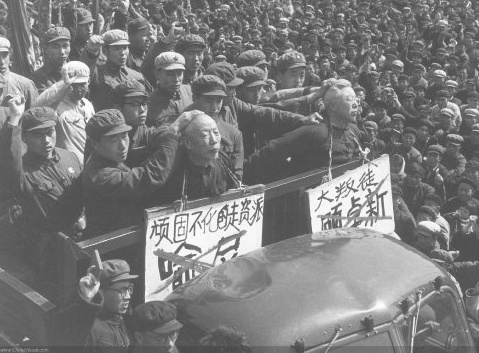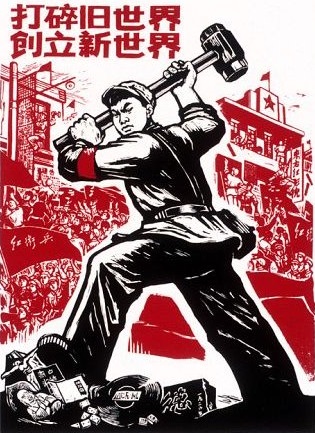
The Cultural Revolution
Summary
In 1966, the world was horrified to see million of uniformed Red Guard youths, waving their 'little red books', attacking their elders and superiors and tearing down traditional Chinese culture.
Historians still do not fully understand what was happening in China during the Cultural Revolution – did it 'run out of control', or did Mao intend things to happen as they did all along?
Links:
The following websites will help you complete the task:
The Cultural Revolution: • About.com
• Chinese posters
'Ken Ling':
• History Learning Site
![]()
![]()
•
Brief review
• Detailed account
Why did Mao launch the Cultural Revolution?
a. A struggle for power
At the Zunyi Conference of 1935, Mao had become the Communists' virtually undisputed leader,
but h had lost some power to the moderates after the failure of the Great Leap Forward, and
had stood down as Chairman of the People's Republic of China in 1959.
However, Mao remained as Chairman of the Communist Party and of the Politbureau, and in 1966 he and his allies launched the 'Cultural revolution', which was Mao's strategy to take back control of the Chinese Revolution. Mao used the Cultural Revolution to eliminate his rivals and take back sole power
b. To secure ‘permanent revolution’
During Mao's period of retirement (1959-66), many of the leading members of the CCP were moderates, who had relaxed the policy of communes and even allowed peasants to sell their produce; Mao wanted to embed a more extreme type of 'permanent revolution' in China
c. Mao’s Little Red Book
After 1962, Mao and Lin Biao began to build up support for Mao, collecting Mao's thoughts into the 'Little Red Book', and launching the Socialist Education Campaign demanding the 'four cleanups' - of politics, the economy, the administration and ideology
d. ‘Learn from the PLA’
As Field-Marshal of the People's Liberation Army, Lin Biao had drilled in propaganda as well as military training, so that the Army were dedicated Maoists
e. Gang of Four
A group of Leftists called the Shanghai Forum, led by the Gang of Four (which included Mao's wife Jiang Qing) took control of the Central Cultural Revolution Group and set about organising the Cultural Revolution
The Cultural Revolution: facts
a. August Rally, 1966
Mao signalled his return to active political life with a publicity swim in the Yangzi; soon after he addressed a huge rally of 1 million young people in Tiananmen Square. His message was to 'Bombard the headquarters' – overwhelming the government with criticism
b. The Four Olds
The campaign identified 'Four Olds' – ideas, culture, customs and habits – which had to be rooted out, by violence if necessary
c. Red Guard terror
Gangs of young Red Guards, dressed in uniform and carrying their Little Red Books, roamed the towns and the countryside, attacking bureaucrats, intellectuals, neo-capitalists and the rich, and attacking religion, traditional culture and buildings etc.
This photograph (1967) shows the humiliation of two men at a mass rally in Shenyang (they were not executed).
Yu Ping (department chief) had been accused of being a 'Capitalist Roader',
Gu Zhuoxin (secretary of the Secretariat) had been branded a 'trator to the
revolution'.

d. ‘Down to the villages’, 1968
As the Red Guards ran out of control, the country fell into anarchy; when Mao felt they had overturned the moderates in the government, he split them up and sent them out to do manual labour in the villages
e. ‘Cleansing the class ranks’
After the Red Guards had been dismissed, the PLA continued the purges – hundreds of thousands of 'counter-revolutionaries' were killed; many more were sent to the Laogai for humiliation and re-education
Impact of the Cultural Revolution on China
a. Fall of Liu Shaoqi and Deng Xiaoping
Liu Shaoqi and Deng Xiaoping were dismissed and put into solitary confinement; Lin Biao and Jiang Qing rose to importance
b. Economic decline
The economy went into crisis – agricultural produce fell – because the workers were called out so often for political rallies or socialist work details, or because they were forced to undergo periods of self-reflection and confession
c. Cultural vandalism
Historic buildings, especially churches and monasteries, were burned – the Forbidden City was only saved because Zhou Enlai sent in the PLA to defend it
In this Government poster, Destroy the old world; build a new world (1966), a young Red Guard crushes the crucifix,
a Buddha and
traditional books with his hammer

d. Education suffered
Schools and colleges closed down as students abandoned their studies to travel the country as Red Guards; teachers were humiliated, beaten and made to clean the toilets
e. Cult of Mao
Mao was worshipped as the infallible leader who had brought Communism to China – he was 'the red sun rising in the east'
Task
Read the following passage by 'Ken Ling' (a Red Guard who fled China to the West at the end of the 1960s). It will help your answers if you also read the
review of Ling's autobiography
![]() ,
and do a Google image seach for "cultural revolution".
,
and do a Google image seach for "cultural revolution".
Then write answers to the questions which follow:
'Ken Ling', Red Guard, 1972
On the Athletic field, I saw rows of teachers, about 40 or 50 in all, with black ink poured over their heads and faces... Hanging on their necks were placards with such words as 'reactionary academic authority so-and-so', class enemy so-and-so' ... They all wore dunce caps ... Hanging from their necks were pails filled with rocks. I saw the principal, the pail round his neck was so heavy that the wire had cut deep into his neck and he was staggering. All were barefoot, hitting broken gongs ... as they walked round the field and begged Mao Zedong to 'pardon their crimes' ...
Beatings and torture followed ... eating nightsoil and insects; being subjected to electric shocks; forced to kneel in broken glass.
How useful is this source to an historian who wants to understand the Cultural Revolution?
Explain how the Cultural Revolution affected China.
Historians have interpreted the Cultural
Revolution as:
• a plot by Mao Zedong to take back power, which got out of control
•
class war - an explosion of anger and revenge by the underprivileged
• a campaign to make the Revolution more 'radical'
Which of these theories best fits the facts?